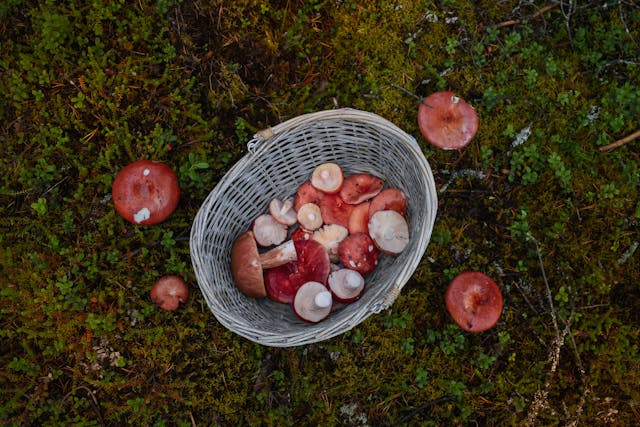Your cart is currently empty!

The call of the wild beckons, not just for adventure, but also for a delicious and unique dining experience! Foraging for wild edibles allows you to connect with nature’s bounty, but remember, responsible foraging is key. Before venturing out, ensure you can properly identify safe plants and understand foraging regulations in your area.
Here’s a guide to get you started, highlighting some common and delicious wild edibles found across various regions of the United States:
Foraging Wild Edibles in the Northeast:
- Dandelion (Taraxacum officinale): Young leaves add a peppery bite to salads, while the golden flowers can be used to make dandelion wine.
- Fiddleheads (Osmunda spp.): The tightly coiled fronds of ferns emerge in spring and can be sautéed or steamed. (Remember, only harvest fiddleheads from sustainable populations).
- Wild Strawberries (Fragaria virginiana): These tiny, sweet berries are a delightful summer treat.
- Chanterelle Mushrooms (Cantharellus cibarius): Trumpet-shaped with a fruity aroma, these prized mushrooms are a gourmet find.
- Sheep Sorrel (Rumex acetosella): The lemony leaves add a tangy flavor to soups and stews.
Foraging Wild Edibles in the Southeast:
- Cattails (Typha spp.): Young shoots can be peeled and cooked like asparagus.
- Muscadine Grapes (Vitis rotundifolia): These juicy, thick-skinned grapes are perfect for jams and jellies.
- Pigweed (Amaranthus spp.): Another fast-growing green with a slightly nutty flavor, pigweed is a versatile addition to salads and stir-fries.
- Maypop (Passiflora incarnata): The sweet-tart fruit offers a refreshing summertime treat.
- Oyster Mushrooms (Pleurotus ostreatus): Fan-shaped with a mild flavor, these mushrooms are perfect for sautéing.
Foraging Wild Edibles in the Midwest:
- Purslane (Portulaca oleracea): A succulent herb with a slightly peppery taste, purslane adds a unique flavor to salads and stir-fries.
- Chicken of the Woods (Laetiporus sulphureus): These bright orange shelf mushrooms have a meaty texture and chicken-like flavor when cooked.
- Wild Asparagus (Asparagus officinalis): Similar to cultivated asparagus, the wild variety has a slightly more intense flavor.
- Blackberries (Rubus fruticosus): These plump, juicy berries are perfect for jams, pies, or simply enjoyed fresh.
- Wild Onions (Allium spp.): Use the leaves like chives or scallions to add a pungent flavor to dishes.
Foraging Wild Edibles in the Southwest:
- Prickly Pear Cactus (Opuntia spp.): The pads can be peeled and roasted, while the fruits are a delicious source of vitamin C. (Important Note: Wear gloves when handling prickly pear cactus to avoid the spines).
- Mesquite Beans (Prosopis spp.): The dried pods can be ground into a flour for baking or used to make a coffee substitute.
- Desert Dandelion (Malacothrix sonchoides): Similar to the common dandelion, the young leaves can be used in salads.
- Wild Arugula (Diplotaxis spp.): This peppery herb adds a zesty kick to salads and sandwiches.
- Chinquapin (Castanea pumila): These small, sweet nuts are a tasty autumn treat.
Foraging Wild Edibles in the West Coast:
- Nettles (Urtica dioica): Once blanched to remove the sting, nettle leaves can be used like spinach in various dishes.
- Fiddlehead Ferns (As mentioned in Northeast): These springtime delights are a delicacy on the West Coast as well.
- Salmonberries (Rubus spectabilis): These large, orange berries have a sweet-tart flavor and are perfect for jams and jellies.
- Chanterelle Mushrooms (As mentioned in Northeast): These prized mushrooms can also be found in West Coast forests.
- Elderberries (Sambucus nigra): The ripe berries (cooked, not raw) can be used to make syrups, jams, and pies. (Important Note: Elderflower and unripe berries are not edible).
Remember: This list is not exhaustive, and always prioritize safety first. Here are some additional tips for responsible foraging:
- Proper Identification: Only forage plants you can confidently identify. Use a reliable field guide or consult an expert.
- Sustainable Practices: Take only what
-
- Focus on Familiar Plants: When starting out, prioritize foraging for plants you can easily identify with confidence.
- Start Small: Don’t harvest a large amount until you’re absolutely certain it’s safe.
- Consult a Local Expert: Consider joining a foraging workshop or consulting with a local expert to learn more about safe foraging practices in your area.
Remember, the thrill of the find should never outweigh safety. By prioritizing responsible foraging and utilizing safe substitutes, you can enjoy the bounty of nature without putting yourself at risk.
And you are going to need some backpacks to haul home your bounty, so check out our store.

Leave a Reply